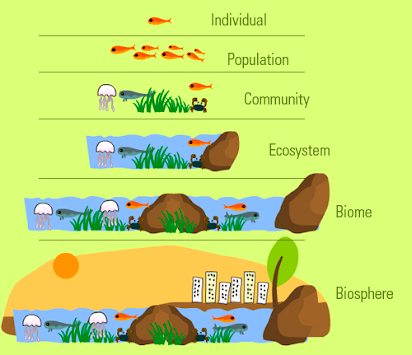Ecosystems and Biomes!!!
Why should we care about biomes and ecosystems?
BIODIVERSITY
What are ecosystems?
- An ecosystem is a "community and interactions of living and nonliving things in an area" (National Geographic).
-Individual plants and animals could not exist on Earth by themselves. For survival, every living thing depends on millions of other living things. An ecosystem is the way various organisms interact within specific regions with the sun, soil, water, air, and other organisms.
-An ecology is a particular region where living things coexist together. It could be hundreds of square miles of desert or a little pool of water. Every ecosystem is unique, and throughout time, each has formed a balance that is crucial to all forms of life that exist there.
What are Biomes?
- "A biome is an area of the planet which can be classified according to the plant and animal life in it" (National Geographic).
- Biomes are determined by climate factors. Examples would include temperature, precipitation, and latitude.
How are ecosystems and biomes interconnected?
-Ecosystems and biomes are linked. Biomes offer a comprehensive overview of life on Earth by emphasizing large-scale patterns and processes, whereas ecosystems go more deeply into the interactions between specific living things and their environments. Biomes are simply described as the "big picture," which is composed of numerous smaller, finer-grained ecosystems.
-The relationship between ecosystems and biomes enables us to comprehend how all living things—from the biggest mammals to the smallest microbes—fit into the larger global ecosystem. It's a relationship that illustrates how interconnected and dependent each element is on the others, revealing the complexity and beauty of the natural world.
Figure 2.

Conclusions:
- Biomes and ecosystems are important for our world. More importantly is keeping the overall balance of these two. The interaction causes energy flow and nutrients to cycle which ensures survival and reproduction for organisms. When it's not balanced, it becomes hard to sustain and maintain biodiversity. Being balanced helps with overall population size, resources, space, predation, and competition. It is important to understand these aspects of the world we live in!!
Figure 3.
Sources:
Samantha, F. and Rebecca R. and James W. (2013). Concepts of Biology. OpenStax.
“Biomes, Ecosystems, and Habitats.” Education, education.nationalgeographic.org/resource/biomes-ecosystems-and-habitats/. Accessed 15 Nov. 2023.
Dr. Rae OsbornAssociate Professor of Biology PhD in Quantitative Biology at in United StatesDr. Rae Osborn was educated in South Africa and the United States. She holds Honors Bachelor of Science degrees in Zoology and Entomology. “Difference between Biome and Ecosystem.” Difference Between, 31 Jan. 2019, www.differencebetween.net/science/nature/difference-between-biome-and-ecosystem/.
“What Is the Difference between a Biome and an Ecosystem?: Socratic.” Socratic.Org, 17 Aug. 2016, socratic.org/questions/57b31d2a7c014932280e8baa.



Comments
Post a Comment